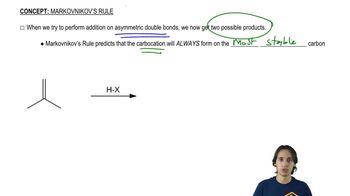Here are the essential concepts you must grasp in order to answer the question correctly.
Asymmetric Centers
Asymmetric centers, or chiral centers, are carbon atoms bonded to four different substituents, leading to non-superimposable mirror images known as enantiomers. In organic molecules, the presence of asymmetric centers is crucial for determining the molecule's stereochemistry, which affects its physical and chemical properties. Identifying these centers is essential for understanding the stereoisomerism of compounds like cholesterol.
Recommended video:
How to add to asymmetrical double bonds.
Stereoisomers
Stereoisomers are compounds that have the same molecular formula and connectivity of atoms but differ in the spatial arrangement of their atoms. This category includes enantiomers and diastereomers, which can have significantly different properties. The number of stereoisomers is determined by the number of asymmetric centers in a molecule, following the formula 2^n, where n is the number of asymmetric centers.
Recommended video:
Determining when molecules are stereoisomers.
Cholesterol Structure
Cholesterol is a complex organic molecule with a specific structure that includes multiple rings and functional groups. It contains several asymmetric centers, which contribute to its stereochemistry. Understanding the structure of cholesterol is vital for answering questions about its stereoisomers, as the arrangement of atoms around these centers directly influences the number of possible stereoisomers.
Recommended video:
Drawing Resonance Structures

 Verified step by step guidance
Verified step by step guidance Verified video answer for a similar problem:
Verified video answer for a similar problem:



 2:15m
2:15m